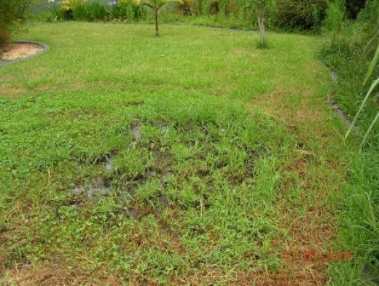Soakaway Drainage Fields, Advice, Design and Installation
Septic Tank Soakaway Systems, Problems and Drainage Fields - How they work
- It uses naturally occurring aerobic soil bacteria to further clean the pollutants in the effluent
- It disperses septic effluent into the soil, without causing problems due to soil saturation and 'Backing-up' of the system.
Over 60% of all sites in the UK FAIL the three mandatory tests required to install a septic tank soakaway. If you can't have a soakaway drainage field, you can't have a septic tank and must consider using a sewage treatment plant instead.
The 3 tests are:
- The site must not be in an Environment Agency Groundwater Source Protection Zone. This is to protect abstracted drinking water
- The site must pass the deep Trial Site Assessment Hole Test and never have either groundwater (the water table) or rock within 1 metre of the soakaway drain pipe
- The site must consist of soil that passes the Percolation Tests - not too sandy or heavy.
The Environment Agency has confirmed to us that DEEP BOREHOLE soakaway drilling as a method of solving drainfield issues is NOT generally acceptable to them, neither are SOAKAWAY TUNNELS, CRATES, ETC. as these are for rainwater soakaways only. BEWARE of such adverts on the Internet and report them to Trading Standards!
If you pass the above tests, then the size of the soakaway drainage field will be dependant on the following factors,
1. The porosity of the soil.
2. The size of the property (based on the number of bedrooms) and the number of residents it serves. The Environment Agency only allow septic tanks for small scale works up to around 15 persons.
However, older septic tank drainfields sometimes did not have to conform to any Building Regulations and may be a simple  long trench, a herringbone drainage layout or even, a large stone filled pit - known as a 'Soakaway'. All these latter types are often not fit for the purpose as they are for rainwater only.
long trench, a herringbone drainage layout or even, a large stone filled pit - known as a 'Soakaway'. All these latter types are often not fit for the purpose as they are for rainwater only.
It is also likely that Percolation tests were not carried out, resulting in them being inadequate and undersized.
All soakaway drainage fields have a limited lifespan which is made shorter if the correct emptying and maintenance of the septic tank is ignored. If you do not empty your tank on a regular basis the suspended solids from the tank will be forced down the drains and into the soakaway, clogging the pipes and contaminating the soil with a black, slimy biomatt, making the drainfield no longer effective.
Rules and Regulations for Septic and Foul Drainage Soakaway Drainfields
- Buildings - 15 metres
- Boundaries - 2 metres
- Water abstraction point (well, spring, bore hole) - 50 metres
- Watercourse (ditch, stream, river) - 10 metres
- No access roads, driveways, paths, buildings, etc. should be within the drainfield area. If it is in a field, then tractors are not allowed to drive over it.
- No water or electric cable or pipes should be within the drainfield area.
- The bedrock or water table should not, at any time, be within 1.2 metres of the drainfield pipework.
If you have a question about your septic tank soakaway give us a call on 01759 369915 and we can normally arrange a free survey and diagnosis of the extent of the soakaway system problem.
We can sometimes get your sewage treatment system, septic tank or soakaway drainfield replaced free of charge if you have Accidental Damage on your Building's Insurance Policy.
